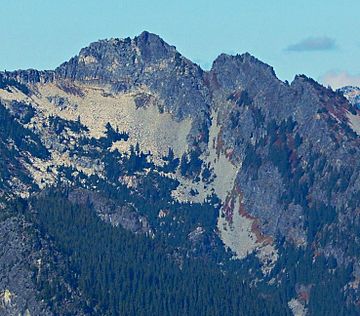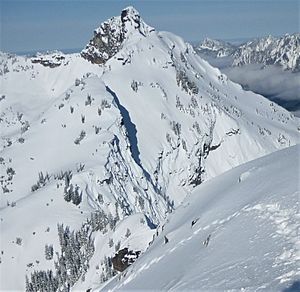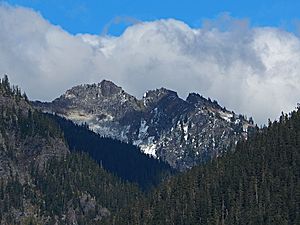Lundin Peak facts for kids
Quick facts for kids Lundin Peak |
|
|---|---|

Lundin Peak from Mount Catherine
|
|
| Highest point | |
| Elevation | 6,057 ft (1,846 m) |
| Prominence | 217 ft (66 m) |
| Isolation | 0.82 mi (1.32 km) |
| Parent peak | Snoqualmie Mountain (6,278 ft) |
| Geography | |
| Location | King County Washington state, U.S. |
| Parent range | Cascade Range |
| Topo map | USGS Snoqualmie Pass |
| Type of rock | Granodiorite |
| Climbing | |
| Easiest route | Scrambling (class 4) |
Lundin Peak is a mountain peak in King County, Washington state. It is part of the Cascade Range and is found inside the Alpine Lakes Wilderness area. Lundin Peak is about three miles north of Snoqualmie Pass. It sits on land managed by the Mount Baker-Snoqualmie National Forest.
The peak was first called Snoqualmie Little Sister. In 1931, its name changed to honor John Lundin, a forest ranger. Lundin Peak is a high point on a ridge between Snoqualmie Mountain and Red Mountain. Water from the mountain flows into the Snoqualmie River.
Weather and Climate at Lundin Peak
Lundin Peak is in a "marine west coast" climate zone. This means it gets a lot of moisture from the Pacific Ocean. Most weather systems start over the Pacific. They then move northeast towards the Cascade Mountains.
When these weather systems reach the mountains, they are forced to rise. As the air goes up, it cools down. This causes the moisture to fall as rain or snowfall onto the Cascades. This process is called Orographic lift. Because of this, the west side of the Cascades gets a lot of rain and snow, especially in winter.
In winter, the weather is usually cloudy. But in summer, high pressure systems over the Pacific Ocean often bring clear skies. The snow here tends to be wet and heavy. This can create a high risk of avalanches. The best time to visit or climb Lundin Peak is usually from July to September. This is when the weather is most pleasant.
How Lundin Peak Was Formed
The Alpine Lakes Wilderness has very rugged land. You can see jagged peaks, deep valleys carved by glaciers, and tall granite walls. There are also over 700 mountain lakes in this area.
The Cascade Range was formed by huge geological events millions of years ago. These events created the different types of land and big changes in height. These changes also led to different climates and types of plants in the area. The land here ranges from about 1,000 feet (300 meters) high to over 9,000 feet (2,700 meters) on Mount Stuart.
The Cascade Mountains started to form millions of years ago, during the late Eocene Epoch. The North American Plate slowly moved over the Pacific Plate. This caused many periods of volcanic activity. Also, small pieces of the Earth's crust, called terranes, helped create the North Cascades about 50 million years ago.
About two million years ago, during the Pleistocene period, glaciers moved across the land many times. As they moved, they scraped the landscape and left behind rock debris. The last time glaciers melted and moved away from the Alpine Lakes area was about 14,000 years ago. They were north of the Canada–US border by 10,000 years ago. The valleys here have a "U" shape. This shape was created by these recent glaciers.
The main forces that created the tall peaks and deep valleys of the Alpine Lakes Wilderness are uplift (when land rises) and faulting (when cracks form in the Earth's crust), combined with the action of glaciers.





